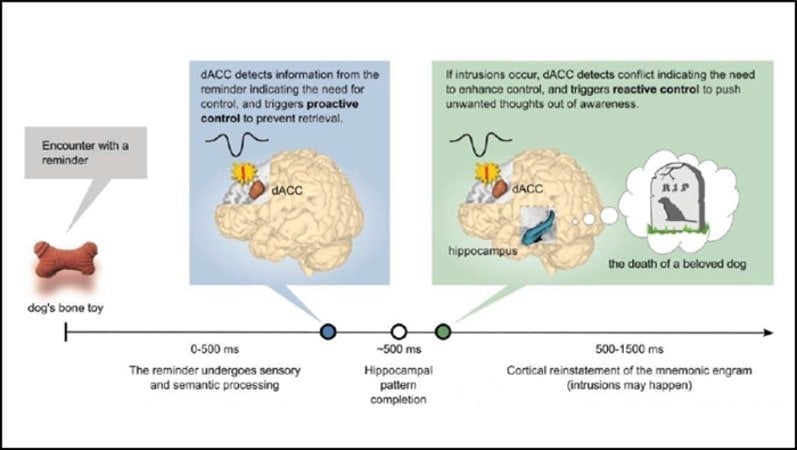Summary: The anterior cingulate cortex generates a reactive alarm, increasing its activity to signal to the dorsolateral prefrontal cortex to stop intrusive thoughts and memories.
Source: SfN
Forget what you saw: a brain region detects when you are about to think of an unwanted memory and alerts other regions to suppress it, according to research recently published in Journal of Neuroscience.
Crespo García et al. measured participants’ brain activity with both EEG and fMRI while they completed a memory task.
The participants memorized sets of words (i.e., gate and train) and were asked to either recall a cue word’s pair (see gate, think about train) or only focus on the cue word (see gate, only think about gate).
During proactive memory suppression, activity increased in the anterior cingulate cortex (ACC), a brain region involved in cognitive control, within the first 500 milliseconds of the task.

The ACC relayed information to the dorsolateral prefrontal cortex (DLPFC), which then inhibited activity in the hippocampus, a key region for memory recall.
The activity levels in the ACC and DLPFC remained low for the rest of the trial, a sign of success — the memory was stopped early enough so no more suppression was needed.
If the memory was not suppressed in time, the ACC generated a reactive alarm, increasing its activity to signal to the DLPFC to stop the intrusion.
About this neuroscience research news
Author: Calli McMurray
Source: SfN
Contact: Calli McMurray – SfN
Image: The image is credited to Crespo García et al
Original Research: Closed access.
“Anterior Cingulate Cortex Signals the Need to Control Intrusive Thoughts During Motivated Forgetting” by Crespo García et al. Journal of Neuroscience
Abstract
Anterior Cingulate Cortex Signals the Need to Control Intrusive Thoughts During Motivated Forgetting
How do people limit awareness of unwanted memories? When such memories intrude, a control process engages the right DLPFC (rDLPFC) to inhibit hippocampal activity and stop retrieval. It remains unknown how the need for control is detected, and whether control operates proactively to prevent unwelcome memories from being retrieved, or responds reactively, to counteract intrusions.
We hypothesized that dorsal ACC (dACC) detects the emergence of an unwanted trace in awareness and transmits the need for inhibitory control to rDLPFC. During a memory suppression task, we measured in humans (both sexes) trial-by-trial variations in dACC’s theta power and N2 amplitude, two EEG markers thought to reflect the need for control.
With simultaneous EEG-fMRI recordings, we tracked interactions between dACC, rDLPFC and hippocampus during suppression.
We found a clear role of dACC in detecting the need for memory control and upregulating prefrontal inhibition. Importantly, we identified distinct early (350-400 ms) and late (500-700 ms) dACC contributions, suggesting both proactive control prior to recollection, and reactive control in response to intrusions.
Stronger early activity was associated with reduced hippocampal activity and diminished BOLD signal in dACC and rDLPFC, suggesting that pre-empting retrieval reduced overall control demands.
In the later window, dACC activity was larger and effective connectivity analyses revealed robust communication from dACC to rDLPFC and from rDLPFC to hippocampus, tied to successful forgetting.
Together, our findings support a model in which dACC detects the emergence of unwanted content, triggering top-down inhibitory control, and in which rDLPFC countermands intruding thoughts that penetrate awareness.
Significance Statement:
Preventing unwanted memories from coming to mind is an adaptive ability of humans. This ability relies on inhibitory control processes in the prefrontal cortex to modulate hippocampal retrieval processes.
How and when reminders to unwelcome memories come to trigger prefrontal control mechanisms remains unknown. Here we acquired neuroimaging data with both high spatial and temporal resolution as participants suppressed specific memories.
We found that the anterior cingulate cortex detects the need for memory control, responding both proactively to early warning signals about unwelcome content and reactively to intrusive thoughts themselves.
When unwanted traces emerge in awareness, anterior cingulate communicates with prefrontal cortex and triggers top-down inhibitory control over the hippocampus through specific neural oscillatory networks.







